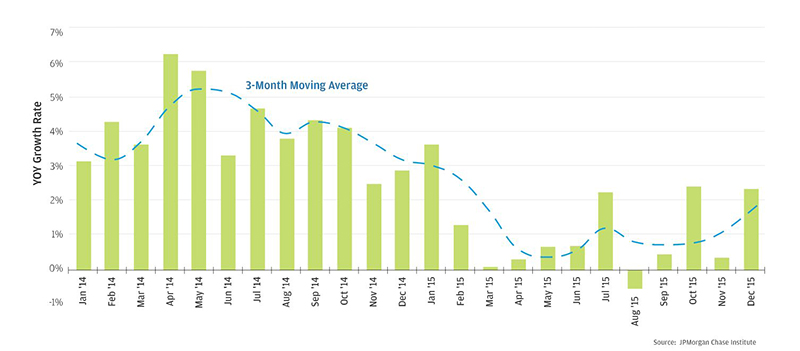Please update your browser.
The economy is still jittery after anemic growth during most of 2015 according to the JPMorgan Chase Institute's Local Consumer Commerce Index (LCCI). However, there are glimmers of hope in the December data, which show year-over-year growth of 2.3 percent. All 15 cities that comprise the LCCI experienced positive growth in December, the first month since January 2015 where we observed across-the-board growth. Small businesses also performed well, contributing 1.7 percentage points of the 2.3 percent total growth in December. And, young consumers and consumers in the bottom income quintile continued to be a bright spot, with these groups contributing over 40 percent of the total growth in December.
These insights are from the most recent update to the LCCI, a measure of the monthly year-over-year growth rate of everyday debit and credit card spending by over 50 million anonymized Chase customers across 15 cities in the U.S. The LCCI was first published in the Institute's December research report, Profiles of Local Consumer Commerce, which highlighted a marked slowdown in consumer commercial spending during the first half of 2015.
The Institute's LCCI is an alternative view of the health and vibrancy of the U.S. consumer and the places where consumers and businesses operate. It offers unique advantages over existing measures of consumer activity:
- Unlike many sources of data on consumer spending, the LCCI captures actual transactions, instead of self-reported measures of how consumers think they spend, with a unique dataset constructed from over 14 billion anonymized debit and credit card transactions.
- The LCCI's geographically specific data provide a granular and timely view of how cities and their surrounding metro areas are faring on a monthly basis.
- The index captures economic activity in consumer facing retail and services sectors that previously have not been well understood by other data sources. These include activities in sectors such as food trucks, new businesses, and personal services.
- The LCCI views local consumer commerce through multiple lenses – consumer age and income, business size and product type, and consumer location relative to the business – allowing us to break down how these attributes contribute to growth.
Moving forward, the LCCI will help inform if the glimmers of hope shown in December will blossom in the spring months, or if the economy will falter as we saw earlier last year. Each release of the LCCI will continue to describe the economic picture of local communities and provide a powerful tool for city development officials, businesses and investors, and statistical agencies to better understand the everyday economic health of consumers, businesses, and the places they care about.


